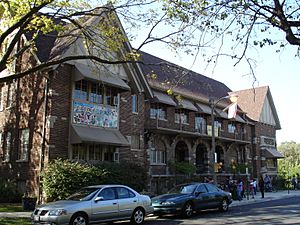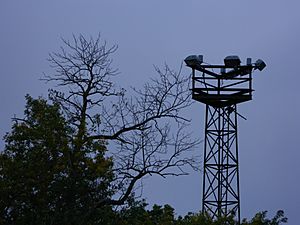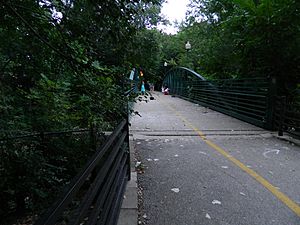Eugene Field Park facts for kids
Quick facts for kids |
|
|
Eugene Field Park
|
|

Eugene Field Park
|
|
| Location | Chicago, Cook County, Illinois, United States |
|---|---|
| Built | 1925 |
| Architect | Henry J. Stockmans, Clarence Hatzfeld |
| Architectural style | Tudor Revival |
| MPS | Historic Resources of the Chicago Park District Multiple Property Submission |
| NRHP reference No. | 06000677 |
| Added to NRHP | August 8, 2006 |
Eugene Field Park is a fun public park in the Albany Park neighborhood of Chicago. It sits right next to the North Branch of the Chicago River. The park is named after a famous writer, Eugene Field.
This park was planned and built between 1923 and 1930. Its main building, called the field house, was finished in 1930. The park has changed a lot over the years. Today, it has tennis courts, sports fields, a playground, and two bridges. In 2006, the park and its old features were added to the National Register of Historic Places. This means it is a special place with important history.
Contents
Park History
Early Years (1920s)
Eugene Field Park covers 16 acres of land. It is located along the North Branch of the Chicago River. The river actually cuts diagonally through the park.
This park was one of two parks created by the Albany Park District. The district started buying land for the park in 1923. At first, it was called Central Park. In November 1926, its name was changed to Eugene Field Park.
The park is named after Eugene Field, an important American writer. He was born in St. Louis but lived in Chicago from 1883. He worked as a journalist. Eugene Field is best known for his children's poems. These include Wynken, Blynken, and Nod and Little Boy Blue.
Growth and Changes (1930s and 1940s)
In the 1930s, many people in Albany Park used Eugene Field Park. It was a popular meeting spot. Older people would gather to play games. Younger people enjoyed dances at the park's field house.
Many community groups used the field house during the Great Depression. This included religious groups and other local clubs. The Chicago Public Library also used the building sometimes.
By 1932, the Albany Park District was having money problems. In 1934, all 22 separate park districts in Chicago joined together. They formed the Chicago Park District. This new, bigger district received a lot of money from the government. This money came from programs like the Works Progress Administration (WPA).
These funds helped improve parks all over Chicago. Eugene Field Park saw many changes. Sports fields were made better. New paths and sidewalks were added. A project in 1941-42 built a retaining wall along the river. A tall, 60-foot light tower was also put up near the tennis courts.
Recent Times (2000s and 2010s)
In 2001, a youth theater group called Albany Park Theater Project moved into the park. They create plays based on stories from the neighborhood.
In 2008, the Illinois Environmental Protection Agency cleaned up part of the park. They removed a lot of illegally dumped trash.
Starting in 2011, the U.S. Army Corps of Engineers worked to improve the river habitats. They wanted to bring back wetland and oak savanna areas. This project also removed plants that were not native to the area.
Flooding Issues
The area around Eugene Field Park has had problems with flooding. Big floods happened in 2008 and 2013. Even in the 1930s, people asked for help with flooding. A project in 1940-41 tried to fix this by digging out the riverbed.
The National Weather Service watches the river level near the park. Seven of the ten highest river levels have happened since 2001. The flood in April 2013 set a new record. The river reached 8.85 feet, which caused a lot of damage. Eugene Field Park usually starts to flood when the water reaches 6.0 feet.
After the 2013 floods, Chicago Mayor Rahm Emanuel announced a new plan. This plan involves building a one-mile tunnel under Foster Avenue. The tunnel will carry extra water to the North Shore Channel. This should help prevent future floods.
Park Features
Sports and Play Areas
The park's tennis courts have been in the same spot since the 1920s. North of the five tennis courts is a playground. In the past, there were two playgrounds and a wading pool.
In the 1950s, the Chicago Park District updated the playground. They added an open shelter and a basketball court. Later, the wading pool was changed into a spray feature. The playground equipment has been updated many times since then.
North of the river, there are large open fields. These fields are used for sports like soccer, football, baseball, and softball. The park is known for its natural river habitat.
Park Buildings and Structures
Field House Design
Clarence Hatzfeld designed the brick field house in 1928. It opened in 1930. The building is in the Tudor Revival style. This style includes special features like half-timbering and patterned bricks. It also has crenellated cornices, which look like castle tops.
Inside the field house, you can see terrazzo floors. The auditorium has its original light fixtures. There is also a marble niche for a drinking fountain on the second floor.
The second floor has two important paintings. One is a painting of Eugene Field from 1941. The other is a mural called The Participation of Youth in the Realm of Fine Arts. This mural was likely created by students in a park district art class. Both paintings were cleaned and restored between 2001 and 2006.
In front of the field house is a circular driveway. It was built around the 1930s. There used to be a fountain in the middle of the driveway. Now, there are ornamental trees and large rocks instead.
Light Tower and Bridges
Eugene Field Park has a 60-foot-tall flood light tower. It was put in place in 1937. The tower provides light for the sports areas. It is still used today.
There are two bridges in the park. One is a footbridge over the Chicago River. It was designed in 1927 and opened in 1928. The bridge has been rebuilt several times. In 1995, the deck was replaced with asphalt. The railings were changed to chain link fencing.
The park's second bridge was built in 2003. It is called the Carmen Avenue Connector. This new bridge connects to a bicycle trail system. This trail links open spaces along the Chicago River. The Carmen Avenue Connector was partly paid for by a grant from the State of Illinois.
Why Eugene Field Park is Special
Eugene Field Park was added to the National Register of Historic Places on August 8, 2006. This means it is recognized for its important history. It is special because of its architecture, its role in recreation, and its social history.
The park has many historic features. Some parts are considered "contributing properties." This means they help show the park's historic nature.










